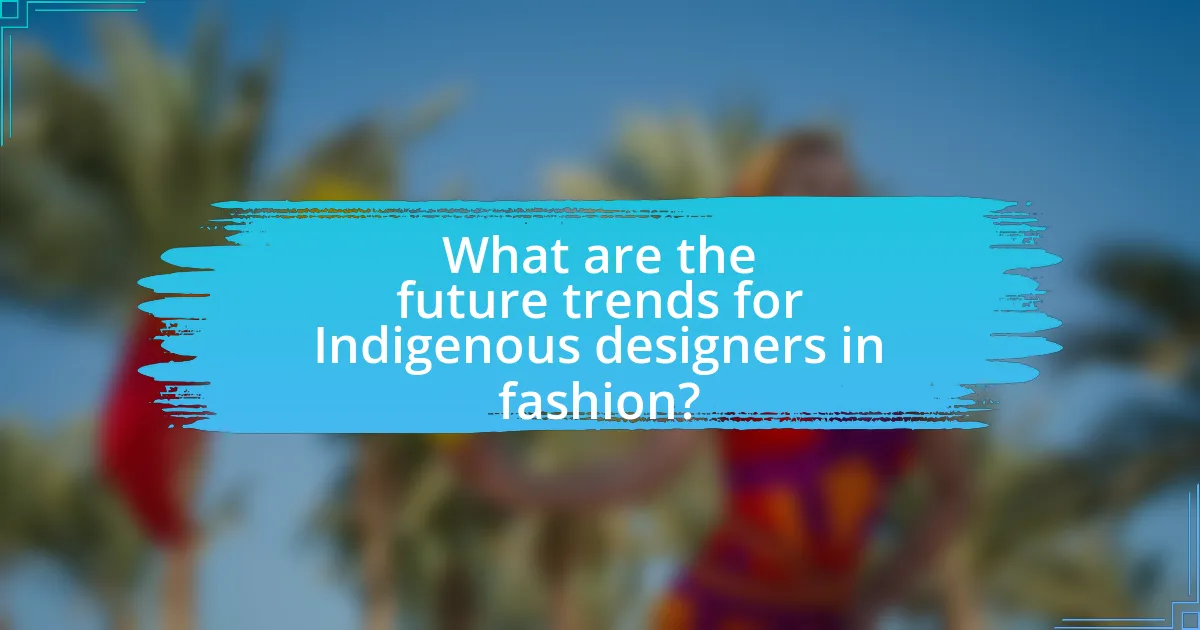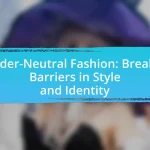Indigenous designers play a crucial role in the fashion industry by integrating unique cultural perspectives, traditional craftsmanship, and storytelling into their work. This article explores the significance of Indigenous designers, highlighting their influence on contemporary fashion trends, the cultural elements they incorporate, and the challenges they face, such as cultural appropriation and systemic barriers. It also discusses the importance of celebrating Indigenous designers for promoting cultural awareness and diversity, as well as initiatives that support their visibility and economic empowerment. Additionally, the article examines how technology and e-commerce platforms enhance the reach of Indigenous fashion, providing consumers with ways to support and make informed choices when purchasing Indigenous designs.

What is the significance of Indigenous designers in the fashion industry?
Indigenous designers hold significant importance in the fashion industry as they bring unique cultural perspectives and traditional craftsmanship that enrich global fashion narratives. Their work often incorporates indigenous materials, techniques, and storytelling, which not only preserves cultural heritage but also challenges mainstream fashion norms. For instance, designers like Bethany Yellowtail and Virgil Ortiz have gained recognition for integrating their Native American heritage into contemporary designs, showcasing the relevance of indigenous aesthetics in modern fashion. This cultural infusion fosters greater diversity and inclusivity within the industry, promoting awareness and appreciation of indigenous cultures among broader audiences.
How do Indigenous designers influence contemporary fashion trends?
Indigenous designers influence contemporary fashion trends by integrating traditional cultural elements, materials, and storytelling into modern designs. This approach not only preserves Indigenous heritage but also introduces unique aesthetics that challenge mainstream fashion norms. For instance, designers like Bethany Yellowtail and Virgil Ortiz incorporate Indigenous motifs and techniques, which resonate with consumers seeking authenticity and cultural significance in their clothing. The rise of Indigenous fashion weeks and collaborations with major brands further amplify this influence, showcasing the richness of Indigenous cultures and promoting sustainable practices.
What cultural elements do Indigenous designers incorporate into their designs?
Indigenous designers incorporate cultural elements such as traditional patterns, symbols, and storytelling into their designs. These elements often reflect the history, spirituality, and identity of Indigenous communities, serving as a means of cultural expression and preservation. For instance, many Indigenous garments feature motifs that represent natural elements or ancestral stories, which are significant to their cultural heritage. This practice not only honors their traditions but also educates broader audiences about Indigenous cultures, fostering appreciation and understanding.
How do these influences reflect Indigenous identity and heritage?
Indigenous influences in fashion reflect Indigenous identity and heritage by incorporating traditional designs, materials, and cultural narratives into contemporary clothing. These elements serve as a means of cultural expression, allowing Indigenous designers to convey their unique histories and values through their work. For instance, the use of specific patterns and motifs often represents tribal affiliations or ancestral stories, reinforcing a sense of belonging and continuity within Indigenous communities. Additionally, the revival of traditional craftsmanship techniques, such as beadwork and weaving, not only honors ancestral practices but also promotes cultural resilience in the face of modernization. This integration of heritage into fashion not only celebrates Indigenous identity but also educates broader audiences about the richness and diversity of Indigenous cultures.
Why is it important to celebrate Indigenous designers?
Celebrating Indigenous designers is important because it acknowledges and honors their unique cultural heritage and contributions to the fashion industry. Indigenous designers often incorporate traditional techniques, materials, and narratives into their work, which enriches the diversity of fashion and promotes cultural understanding. For instance, the use of indigenous textiles and patterns not only showcases craftsmanship but also tells stories that reflect the history and identity of Indigenous communities. By celebrating these designers, the fashion industry can challenge mainstream narratives, support economic empowerment within Indigenous communities, and foster a more inclusive environment that values diverse perspectives and creativity.
What role do Indigenous designers play in promoting cultural awareness?
Indigenous designers play a crucial role in promoting cultural awareness by integrating traditional practices, stories, and symbols into contemporary fashion. Their work not only showcases Indigenous heritage but also educates broader audiences about the significance of cultural elements, fostering respect and understanding. For instance, designers like Bethany Yellowtail and Virgil Ortiz incorporate Indigenous narratives and craftsmanship into their collections, which helps to challenge stereotypes and highlight the richness of Indigenous cultures. This approach not only preserves cultural identity but also encourages dialogue around Indigenous issues, making their contributions vital in the landscape of cultural awareness.
How does recognition of Indigenous designers impact the fashion industry?
Recognition of Indigenous designers significantly impacts the fashion industry by promoting cultural diversity and authenticity. This acknowledgment allows Indigenous designers to showcase their unique perspectives and traditional craftsmanship, which enriches the fashion landscape. For instance, brands like Kaha:wi Dance Theatre and designer Lesley Hampton have gained visibility, leading to increased consumer interest in ethically produced and culturally inspired fashion. Furthermore, the inclusion of Indigenous narratives in fashion helps challenge stereotypes and fosters a greater understanding of Indigenous cultures, as seen in the rise of collaborations between Indigenous artists and mainstream brands. This shift not only supports Indigenous communities economically but also encourages sustainable practices within the industry, as many Indigenous designers prioritize eco-friendly materials and methods.

What challenges do Indigenous designers face in the fashion world?
Indigenous designers face significant challenges in the fashion world, primarily due to cultural appropriation, lack of representation, and limited access to resources. Cultural appropriation occurs when non-Indigenous designers exploit Indigenous designs and symbols without permission or understanding, undermining the cultural significance of these elements. Additionally, Indigenous designers often struggle with representation in mainstream fashion, as they are frequently marginalized and overlooked in industry opportunities. Limited access to funding, mentorship, and networks further exacerbates these challenges, making it difficult for Indigenous designers to establish and grow their brands. These factors collectively hinder the ability of Indigenous designers to thrive and share their cultural narratives within the fashion industry.
How do systemic barriers affect Indigenous designers’ visibility?
Systemic barriers significantly diminish Indigenous designers’ visibility by limiting access to resources, networks, and platforms essential for showcasing their work. These barriers include economic disparities, lack of representation in mainstream fashion media, and institutional biases that favor established designers over emerging Indigenous talent. For instance, a study by the National Indigenous Economic Development Board highlights that Indigenous entrepreneurs face higher rates of unemployment and lower access to funding, which directly impacts their ability to promote their designs. Additionally, the absence of Indigenous voices in decision-making roles within fashion organizations perpetuates a cycle of invisibility, making it challenging for Indigenous designers to gain recognition and support in the industry.
What are the common misconceptions about Indigenous fashion?
Common misconceptions about Indigenous fashion include the belief that it is solely traditional and static, rather than dynamic and contemporary. Many people assume that Indigenous fashion only consists of historical garments, ignoring the fact that Indigenous designers actively innovate and blend traditional elements with modern aesthetics. Additionally, there is a misconception that Indigenous fashion lacks diversity, when in reality, it encompasses a wide range of styles, materials, and cultural influences across different Indigenous communities. This diversity is evident in the works of contemporary Indigenous designers who draw inspiration from their heritage while addressing current fashion trends.
How can the fashion industry better support Indigenous designers?
The fashion industry can better support Indigenous designers by prioritizing equitable partnerships and providing platforms for visibility. By collaborating directly with Indigenous creators, brands can ensure that cultural narratives are authentically represented and that designers receive fair compensation for their work. For instance, initiatives like the Indigenous Fashion Week in Toronto have successfully showcased Indigenous talent, highlighting the importance of dedicated spaces for these designers. Additionally, implementing mentorship programs can help bridge the gap between established industry professionals and emerging Indigenous designers, fostering skill development and networking opportunities.
What initiatives exist to promote Indigenous fashion?
Various initiatives exist to promote Indigenous fashion, including fashion shows, educational programs, and collaborations with mainstream brands. For instance, events like the Indigenous Fashion Week in Toronto showcase Indigenous designers and their work, providing a platform for visibility and cultural expression. Additionally, organizations such as the Canadian Council for Aboriginal Business support Indigenous entrepreneurs in the fashion industry through mentorship and funding opportunities. These initiatives not only elevate Indigenous voices in fashion but also foster cultural appreciation and economic empowerment within Indigenous communities.
Which organizations are dedicated to supporting Indigenous designers?
Organizations dedicated to supporting Indigenous designers include the Indigenous Fashion Arts (IFA), the Council of Fashion Designers of America (CFDA), and the Native American Arts and Crafts Association (NAACA). The Indigenous Fashion Arts organization focuses on promoting Indigenous designers through events and initiatives that highlight their work and cultural heritage. The CFDA has programs aimed at increasing diversity in fashion, which includes support for Indigenous talent. The NAACA works to promote and protect Native American arts and crafts, providing a platform for Indigenous designers to showcase their creations. These organizations play a crucial role in fostering visibility and opportunities for Indigenous designers in the fashion industry.
How do fashion shows and events highlight Indigenous talent?
Fashion shows and events highlight Indigenous talent by providing a platform for Indigenous designers to showcase their unique cultural heritage and craftsmanship. These events often feature collections that incorporate traditional motifs, materials, and techniques, allowing designers to express their identity and tell their stories through fashion. For instance, events like the Indigenous Fashion Week in Toronto have successfully spotlighted Indigenous designers, attracting media attention and fostering greater appreciation for their work. This visibility not only elevates Indigenous voices in the fashion industry but also educates audiences about the significance of Indigenous culture and artistry, thereby promoting cultural awareness and respect.

What are the future trends for Indigenous designers in fashion?
Future trends for Indigenous designers in fashion include a growing emphasis on sustainability, cultural storytelling, and collaboration with mainstream brands. Indigenous designers are increasingly integrating traditional techniques and materials into contemporary fashion, which not only preserves cultural heritage but also appeals to eco-conscious consumers. For example, the use of natural dyes and sustainable fabrics is becoming more prevalent, reflecting a commitment to environmental stewardship. Additionally, collaborations between Indigenous designers and established fashion houses are on the rise, enhancing visibility and market reach while fostering cultural exchange. This trend is supported by initiatives like the Indigenous Fashion Week, which showcases Indigenous talent and promotes cultural narratives through fashion.
How is technology influencing Indigenous fashion design?
Technology is significantly influencing Indigenous fashion design by enabling designers to incorporate digital tools and platforms for creation, promotion, and distribution. For instance, the use of 3D printing allows Indigenous designers to experiment with new materials and forms, enhancing traditional designs with modern techniques. Additionally, social media platforms provide a global stage for Indigenous designers to showcase their work, reach wider audiences, and engage in cultural storytelling. This digital presence not only elevates Indigenous fashion but also fosters a sense of community and cultural exchange, as seen in initiatives like the Indigenous Fashion Week in Toronto, which highlights the intersection of technology and traditional craftsmanship.
What role does social media play in promoting Indigenous designers?
Social media plays a crucial role in promoting Indigenous designers by providing a platform for visibility and engagement with a global audience. Through platforms like Instagram and Facebook, Indigenous designers can showcase their work, share their cultural narratives, and connect directly with consumers, bypassing traditional barriers in the fashion industry. For instance, the hashtag #IndigenousFashion has gained traction, allowing designers to reach wider audiences and foster community support. This increased visibility has led to greater recognition and appreciation of Indigenous artistry, as evidenced by the rise in collaborations and features in mainstream fashion events and publications.
How can e-commerce platforms enhance the reach of Indigenous fashion?
E-commerce platforms can enhance the reach of Indigenous fashion by providing a global marketplace that connects Indigenous designers with a wider audience. These platforms enable designers to showcase their unique cultural narratives and craftsmanship, which can attract consumers interested in authentic and ethically sourced fashion. For instance, platforms like Etsy and Shopify have successfully facilitated the sale of Indigenous fashion items, allowing designers to reach customers beyond their local communities. Additionally, e-commerce platforms can leverage social media marketing and targeted advertising to promote Indigenous fashion, increasing visibility and sales. According to a report by McKinsey & Company, online sales in the fashion industry are projected to grow significantly, indicating a substantial opportunity for Indigenous designers to capitalize on this trend.
What can consumers do to support Indigenous designers?
Consumers can support Indigenous designers by purchasing their products directly from their brands. This action not only provides financial support but also helps to promote Indigenous culture and craftsmanship. According to a report by the National Indigenous Economic Development Board, supporting Indigenous businesses contributes to economic growth within Indigenous communities, fostering sustainability and cultural preservation. Additionally, consumers can advocate for Indigenous representation in the fashion industry by sharing Indigenous designers’ work on social media and encouraging retailers to stock their products, thereby amplifying their visibility and reach.
How can individuals make informed choices when purchasing Indigenous fashion?
Individuals can make informed choices when purchasing Indigenous fashion by researching the designers and brands to ensure they are authentically Indigenous-owned and operated. Authentic Indigenous fashion is often characterized by cultural significance, traditional techniques, and ethical practices that reflect the heritage of the community. For instance, organizations like the Indigenous Fashion Association provide resources and directories of verified Indigenous designers, helping consumers identify genuine products. Additionally, understanding the cultural context and stories behind the designs enhances appreciation and respect for the artistry involved. Engaging with the designers through social media or events can also provide insights into their practices and values, ensuring that purchases support the community and its cultural preservation.
What are the best practices for collaborating with Indigenous designers?
The best practices for collaborating with Indigenous designers include establishing respectful relationships, prioritizing cultural understanding, and ensuring fair compensation. Respectful relationships involve engaging with Indigenous communities and recognizing their cultural heritage, which fosters trust and collaboration. Prioritizing cultural understanding requires designers to educate themselves about Indigenous traditions, values, and aesthetics, ensuring that the collaboration honors these elements. Fair compensation is crucial, as it acknowledges the intellectual property and labor of Indigenous designers, promoting equitable partnerships. These practices are supported by initiatives like the Indigenous Fashion Week, which emphasizes the importance of ethical collaboration in the fashion industry.

















